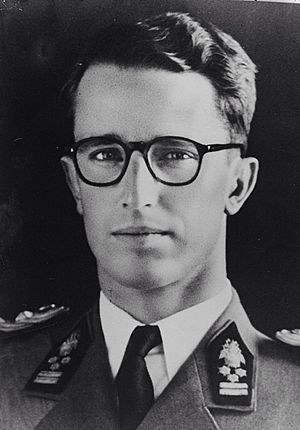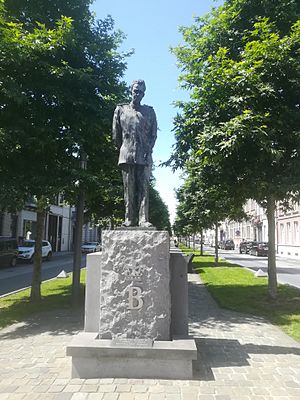Baudouin of Belgium facts for kids
Quick facts for kids Baudouin |
|||||
|---|---|---|---|---|---|

King Baudouin in 1960
|
|||||
| King of the Belgians | |||||
| Reign | 17 July 1951 – 31 July 1993 | ||||
| Predecessor | Leopold III | ||||
| Successor | Albert II | ||||
| Prime ministers |
See list
Joseph Pholien
Jean Van Houtte Achille Van Acker Gaston Eyskens Théo Lefèvre Pierre Harmel Paul Vanden Boeynants Edmond Leburton Leo Tindemans Wilfried Martens Mark Eyskens Jean-Luc Dehaene |
||||
| Born | 7 September 1930 Stuyvenberg Castle, Laeken, Brussels, Kingdom of Belgium |
||||
| Died | 31 July 1993 (aged 62) Villa Astrida, Motril, Kingdom of Spain |
||||
| Burial | Church of Our Lady of Laeken | ||||
| Spouse | |||||
|
|||||
| House | Belgium | ||||
| Father | Leopold III of Belgium | ||||
| Mother | Astrid of Sweden | ||||
| Religion | Roman Catholicism | ||||
Baudouin (born 7 September 1930), also known by his Dutch name Boudewijn, was the King of the Belgians. He ruled from 17 July 1951 until his death in 1993. He was the last Belgian king to also be the ruler of the Belgian Congo, before it became independent.
Baudouin was the older son of King Leopold III and his first wife, Princess Astrid of Sweden. He and his wife, Queen Fabiola, did not have any children. Because of this, when Baudouin passed away, the crown went to his younger brother, King Albert II.
Contents
Early Life and Becoming King
Prince Baudouin was born on 7 September 1930 at Château du Stuyvenberg in Brussels. He was the second child and older son of Prince Leopold, who was then the Duke of Brabant, and Princess Astrid of Sweden. In 1934, Baudouin's grandfather, King Albert I of Belgium, died in a climbing accident. Leopold became king, and three-year-old Baudouin became the Duke of Brabant. This meant he was next in line to the throne.
Baudouin's mother died in a car accident in 1935, when he was almost five years old. Later, in 1941, his father married Mary Lilian Baels, who became Princess of Réthy. They had three more children: Prince Alexandre, Princess Marie-Christine, and Princess Marie-Esméralda. Baudouin and his siblings had a good relationship with their stepmother and called her "Mother."
Baudouin started his education at age seven. His teachers taught him half his lessons in French and half in Dutch. He often went with his father to parades and ceremonies, becoming well-known to the public.
World War II and Exile
Even though Belgium tried to stay neutral at the start of Second World War, Nazi Germany invaded on 10 May 1940. Baudouin, his older sister Princess Josephine-Charlotte, and his younger brother Prince Albert were quickly sent to France for safety, and then to Spain. The Belgian Army fought for 18 days, but King Leopold, who was in charge, surrendered on 28 May.
The Belgian government escaped to form a government in exile. However, Leopold chose to stay in Belgium and was put under house arrest at the Palace of Laeken. He tried to make agreements with the Germans, especially about Belgian prisoners of war. The royal children returned to Laeken from Spain on 6 August.
In April 1943, the German forces banned wearing uniforms. Leopold insisted this ban should apply to his sons' royal Scout group too. But Baudouin was about to become an official Scout. He convinced his father to delay the ban for one day so his ceremony could happen.
After the Normandy landings in June 1944, the king, his new wife Princess Lilian, and the royal children were sent to Germany. They were then moved to Austria, where the United States Army freed them in May 1945.
The Royal Question and Abdication
However, the royal family could not return to Belgium right away. There was a big debate called the "Royal Question" about whether Leopold had worked with the Nazis. People questioned his surrender in 1940, his choice not to join the government-in-exile, and his visit to Adolf Hitler.
Until a political solution was found, the king's brother, Prince Charles, became the regent (a temporary ruler). The royal family lived in Switzerland. Baudouin continued his schooling in Geneva and visited the United States in 1948.
In a vote in March 1950, the public narrowly voted for the king to return. He came back on 4 June 1950. But disagreements in parliament and public protests forced Leopold to give his powers to Baudouin on 11 August 1950. Finally, Leopold decided to give up the throne for Baudouin. Baudouin officially became King of the Belgians on 17 July 1951.
Marriage to Queen Fabiola

On 15 December 1960, Baudouin married Doña Fabiola de Mora y Aragón in Brussels. Fabiola was a Spanish noblewoman who worked as a nurse. They announced their engagement on 16 September 1960.
Fabiola immediately started her official duties, joining the king at public events. She remained an active Queen and later Queen Dowager throughout her life. She was very involved in social causes, especially those related to mental health, children, and women.
The king and queen did not have any children.
Important Events During His Reign
A major event during Baudouin's reign was when the colony of Belgian Congo became independent. During the independence parade, the king's ceremonial sword was briefly taken by a man named Ambroise Boimbo. This moment was captured in a famous photograph. The next day, the king gave a speech, which was strongly criticized by the Congolese Prime Minister Patrice Lumumba.
As the head of state of Belgium, Baudouin attended the state funerals of two American presidents: John F. Kennedy in November 1963 and Dwight D. Eisenhower in March 1969.
In 1976, to celebrate Baudouin's 25th year as king, the King Baudouin Foundation was created. Its goal was to improve the lives of the Belgian people.
He received many honors, including being the 1,176th Knight of the Order of the Golden Fleece in Spain and the 930th Knight of the Order of the Garter.
Baudouin and Congo's Independence
In 1960, King Baudouin declared the Belgian colony of Congo independent. During the independence ceremony, Baudouin gave a speech that praised the actions of the first Belgian ruler of Congo, King Leopold II. He called Leopold II "a genius." On the same day, Congo's first democratically elected prime minister, Patrice Lumumba, gave a speech that strongly criticized the Belgian rule. Lumumba spoke about the many Congolese who were killed, insulted, humiliated, and enslaved.
Lumumba's speech made Baudouin very angry and caused a lot of conflict between them. After Congo became independent, the Katanga Province, which was rich in natural resources, tried to break away from Congo. This effort received significant support from the Belgian government and Belgian companies. King Baudouin strengthened his ties with the Katangese politician Moise Tshombé.
In 2001, a special investigation by the Belgian government looked into the events surrounding Lumumba's death. The investigation concluded that King Baudouin was aware of plans to "neutralize" Lumumba. The report stated that the king did not do anything to stop these plans. His lack of action was described as "incriminating," meaning it suggested he was involved by not acting, but there was no proof that he directly ordered the killing.
Death and Legacy

King Baudouin ruled for 42 years. He passed away from heart failure on 31 July 1993 in Spain. Although he had heart surgery in 1992, his death was unexpected. It caused a period of deep sadness across Belgium.
After his death, people spontaneously covered the Royal Palace gates with flowers. About 500,000 people, which is 5% of Belgium's population, came to the Royal Palace in Brussels to pay their respects. Many waited in line for up to 14 hours in hot weather to see their King one last time.
Many world leaders attended his funeral service. This included Queen Elizabeth II of the United Kingdom, Emperor Akihito of Japan, and more than 20 presidents and leaders.
King Baudouin was buried in the royal vault at the Church of Our Lady of Laeken in Brussels. His younger brother, who became King Albert II, succeeded him.
A statue of King Baudouin in Brussels was damaged in June 2020 during protests.
See also
 In Spanish: Balduino de Bélgica para niños
In Spanish: Balduino de Bélgica para niños
- Kings of Belgium family tree
- Crown Council of Belgium
- Royal Trust
- King Baudouin Ice Shelf, Antarctica



